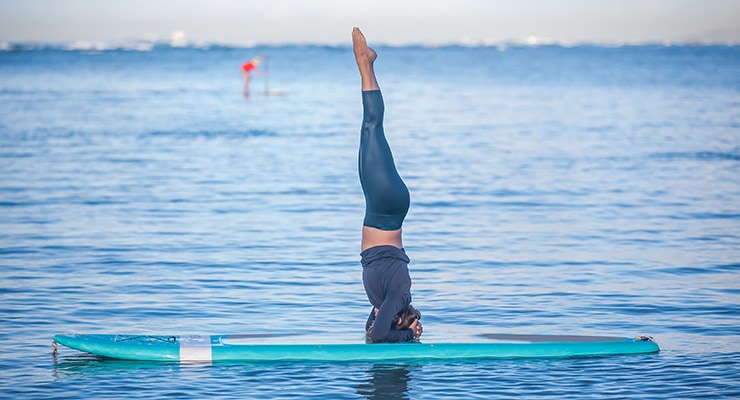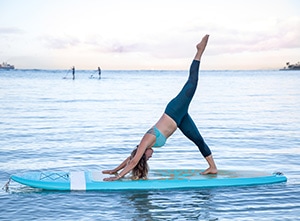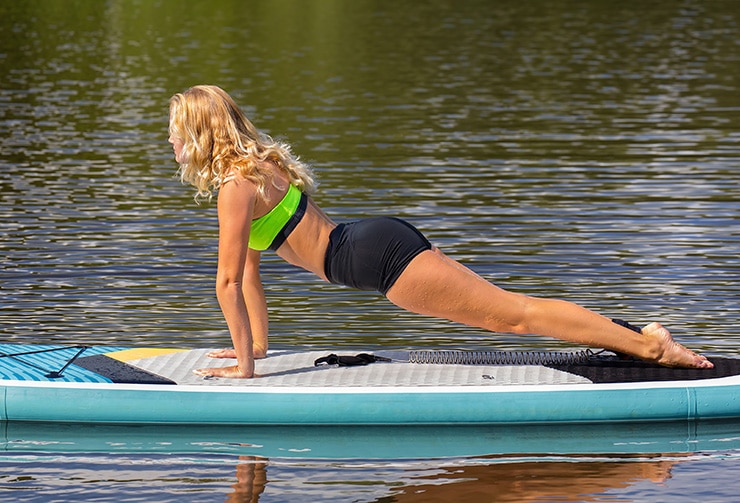If you’re just getting started in the world of paddle board yoga, you’ll need to start off nice and slow. SUP yoga might look pretty easy and straightforward, but it does require some significant core and arm strength. You also need to have a decent sense of balance to execute your poses.
Today, I’ll dive into the details about how to prepare your body for your first paddle board yoga adventure. If you’re a seasoned paddle board yogi, I’ve got some great tips for you too. Stick around to see how improving your breathing and flexibility can give you a greater experience when you’re out on the water. Let’s get started!
RELATED: What is the Best Stand Up Paddle Board for Yoga of 2024?
Basic Strengths Every Paddler Should Have
No matter what type of paddle boarding exercise you do, it’s important to have the basic skills under your belt before you go all in. In the same way you can’t ride a bike without understanding the basics, you can’t be successful at paddle board yoga until you understand how your paddle board works.
When you’re out paddle boarding, you’re going to use your core muscles a lot. Even before you get to the actual yoga, your core muscles are important when it comes to helping you stay stable on the board.
You can also expect to use your arm muscles quite a bit as you balance yourself. And if you fall off your paddle board, just which muscles will you be using to lift yourself up? You guessed it; your arm muscles. So of course a certain amount of upper body strength is needed for this type of activity.
With that being said, here are the key basics strengths every paddler should have for SUP yoga.
A Good Sense of Balance
It goes without saying that balance is critical to paddle board yoga. When you’re getting into those poses that require you to balance on one leg, the greater sense of balance you have, the more successful you’ll be. Luckily, balance is something you can always improve upon.

Improve Your Balance With a Stable Paddle Board
The best way to improve your balance on your yoga SUP is simply by paddling. When you go out paddle boarding, you’ll get a sense of how your paddle board reacts to your shifting weight. As you adjust your body, you slowly get a sense of how to balance yourself.
The more you paddle, the more you’ll begin to understand when too much weight on one side of the board can throw you off balance. You’ll also be able to better gauge how your movements, paddle strokes, and even the water underneath you impact your balance.
As you get a sense of how the board performs, you’ll be able to recognise how you should react. This feedback look is what will ultimately improve your balance.
A Modest Amount of Core Strength

You need a modest amount of core strength in order to do paddle board yoga. As I mentioned earlier, your core strength is critical to helping you maintain your balance on the board. But your core strength goes beyond just paddle boarding. Having a modest amount of core strength will allow you to actually execute the paddle board yoga poses.
If you have ever done yoga poses on land, you know just how difficult it can be to keep your core engaged and tight. After all, it’s the whole point of yoga. A core that is tight and engaged will help keep you stable as you work out. This stability results in less shaking of your body which in turn allows you to maintain your balance on the board.
If you have very minimal no core strength, you can still prepare for paddle board yoga. Start with simple poses that focus more on balancing and stretching. As your core strength develops, you can move to more advanced poses on your board.
You can improve your core by strengthening your muscles on land first. Incorporate core exercises into your daily workout routine to help strengthen these muscles. Overtime, your efforts will pay off and you will feel the difference when you jump over to SUP yoga.
Upper Body Strength
Don’t forget about your upper body muscles. Your shoulders, arms, and mid back muscles all play a role in SUP yoga. You’re either going to be using these muscles during your yoga poses, or when you’re getting back onto your board after falling into the water. Either way. it’s important that you have some strength in these muscles to help you as you go.
One of the best ways to strengthen this group of muscles is by doing some upper body workouts on land. If you jump onto an SUP board and go all out on a workout, you’ll feel the soreness the very next day. By getting into a routine before you go on the water, you’ll have a more comfortable experience.
ALSO READ: What Muscles Does Paddle Boarding Work?
What Kind of Strength Does Advanced SUP Yoga require?
If you’re comfortable with your body’s strength level, then it’s time to enhance your SUP yoga experience. Focus on improving your flexibility and your breathing. When you can get greater control over both, you will have a more rewarding time during your SUP yoga session.
ALSO READ: What paddleboard yoga clothing works best?
Strength Through Flexibility
Flexibility goes beyond just stretching. Enhancing your flexibility means engaging muscles that allow you to have a greater reach during yoga poses. The more you practice flexibility, the greater control you will have when you execute a pose.
To enhance your flexibility, consider picking out a group of muscles to focus on. Improving these muscles will help you perfect current or new poses. Often, you may want to focus on your hip flexors, hamstrings, and even back muscles.
Stretch out these muscles for at least five minutes five times a day. This will help you with your flexibility as you work towards new poses.
An Understanding of Breathing Techniques
You don’t have to be Wim Hoff to understand that breathwork has a direct impact on your performance. Don’t underestimate the power of breathing! When you focus your efforts on intentional breathing, you’ll have a more rewarding SUP yoga experience.
Improving your breathing technique has been proven to help with stamina and mindfulness.
Deep Core Strength
As with any workout, you can always challenge yourself to dig deeper when you are doing SUP yoga. One way to do this is by enhancing your core strength. Both on land and on the water, focus your efforts on your deep core muscles.
Working out your transverse abdominis and your pelvic floor will help you enhance your stability. This in turn will allow you to practice a more rigorous yoga SUP session.
YOU MAY ALSO LIKE: 10 Gorgeous SUP Yoga Retreats to Get Away To
Conclusion
While you do need a basic level of strength for SUP yoga, you can always start no matter your skill level. The most important thing to keep in mind is that practice makes perfect.
Develop your strength over time by getting into a routine and working out new muscle groups. The more you do so, the more you’ll be able to feel the difference in your SUP yoga routine.

